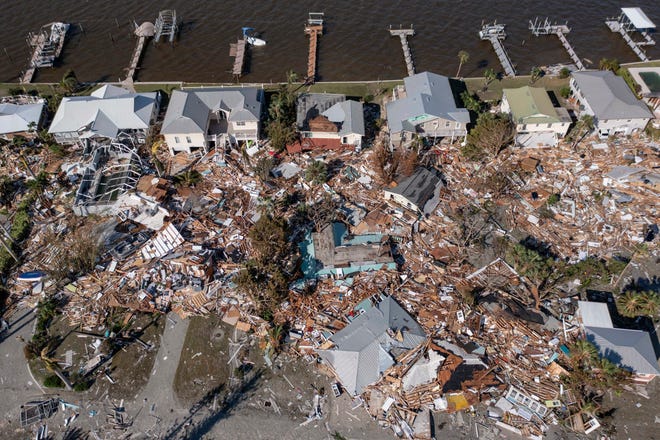[ad_1]
A post-season analysis of deadly Hurricane Ian found the storm briefly intensified to a Category 5 storm with winds of 161 mph last September as it moved into the Gulf of Mexico on its way to Florida.
The upgraded status was just one piece of a fact-filled after-storm report on Ian released Monday by the National Hurricane Center.
By the time Ian made landfall nine hours later on Cayo Costa, a barrier island on Florida’s southwest coast, its sustained winds had dropped. But only to an estimated 149.6 mph, enough to leave catastrophic death and destruction in its wake.
For millions living in the nation’s hurricane prone regions, the lives lost as a result of Ian’s massive storm surge and extreme rainfall are the most important lesson, said Daniel Noah, warning coordination meteorologist for the National Weather Service office in Tampa Bay.
Water caused 94% of the 66 deaths directly attributed to Ian in Florida, said Noah, who helped conduct after storm damage assessments.
“Water kills,” he said. “People should avoid water during hurricanes. Don’t drive on flooded roads. Don’t drive during heavy rains. You’re putting your life at risk if you don’t prepare for the storm.”
Hurricane Center changing outlook:In 2023, it will forecast 7 days out.
How storm surge works:Graphics explain the deadly weather event.
Ian’s peak winds:
With 126.6 mph winds as it crossed over the Dry Tortugas into the Gulf of Mexico on the night of Sept. 27, Ian made the most of the Gulf’s warmer waters.
Meteorologists and hurricane forecasters knew the storm had rapidly intensified during an eyewall replacement cycle in the hours after entering the Gulf, but the new report clarified that increase. Data from flights by the Air Force Reserve and NOAA aircraft show Ian’s winds increased to 161 mph as its radius and wind field expanded
That makes it one of 39 Atlantic hurricanes to be labeled a “5” on the Saffir-Simpson scale, the category reserved for only the most intense storms.
Fortunately for Florida, the burst of intensity was brief. Ian slammed into Cayo Costa with 150 mph winds, Ian’s strength dropped to an estimated 140 mph when the hurricane moved over Punta Gorda 90 minutes later.
As with other legendary hurricanes, no one will ever know just how powerful the winds were, because weather stations tend to fail when the strongest winds arrive.
“No reliable surface observations exist from the coastal areas where the eyewall came on shore,” the hurricane center wrote. And no reconnaissance aircraft were in the vicinity.

How many deaths were there?
In total, 156 people died in the U.S., ranging in age from six to 101. Most were in Florida and most were elderly. While that may reflect the demographics of Southwest Florida, where most of the deaths occurred, the elderly deaths are consistent with other hurricanes.
In Florida:
- All of Ian’s 66 direct deaths in the U.S. occurred in Florida.
- 62 were the result of water, either storm surge or rainfall
- Storm surge caused 41 deaths, 36 in Lee County
- Rainfall caused 21 deaths
- At least 13 are still missing, including a couple living on a boat set adrift off the Florida Keys and 11 of 27 Cuban migrants on a boat that capsized off the Keys in rough surf. Four passengers swam to shore, five were rescued and seven were found dead.
Another 90 casualties are indirectly attributed to Ian:
- 84 in Florida
- 5 in North Carolina
- 1 in Virginia
The leading causes of those deaths were:
- Lack of access to timely medical care – 18
- Accidents – 16
- Cardiac arrests – 16
Retiring hurricane names:Ian, Fiona retired because of 2022 death and destruction
Is climate change fueling hurricanes? Here’s what science says.

How high was Ian’s storm surge?
As initially reported, the highest storm surge was an estimated 15 feet inside the second story of beachfront structures on Fort Myers Beach. Here’s the surge elsewhere (in feet above ground level):
Florida:
- Eastern portion of Sanibel Island: 9-13
- Estero, Bonita Beach and Bonita Springs: 8-12
- Pine Island, Cape Coral, Naples: 6-9
- Fort Myers, inland where the surge reversed the Caloosahatchee River’s flow: 5-8
- East coast from Volusia County north to the border: 3-5
- Inland along the St. Johns River in North Florida: 2-4
Georgia and South Carolina:
- Georgia to Charleston, South Carolina: 2-4
- Georgetown and Horry Counties, South Carolina: 4-6
- South of Cape Fear in North Carolina: 3-5
How much rainfall did Ian produce?
- 10-20 inches across much of Florida.
- The highest – 26.95 inches – fell in Grove City, just north of landfall.
- On Florida’s east coast, 21.49 inches was reported in Daytona Beach.
- Charleston, South Carolina, 10.75 inches of rain was observed.
How many tornadoes were there?
- Fifteen, 14 in outer rain bands over Florida, including an EF-2 tornado in Palm Beach County and an EF-1 tornado in Pembroke Pines.
- One tornado was reported on the North Carolina coast.
Dig deeper
Ian leaves least 144 dead:Why do predictable storms still kill so many people
No easy fixes:Could Hurricane Ian’s havoc bring a call for better planning?
‘Cone of uncertainty’:Many people misunderstand this forecast graphic. It can be a deadly mistake.
A climate reckoning:Too many homes in harm’s way, ‘too many zeros’ in the costs

[ad_2]
Source link





